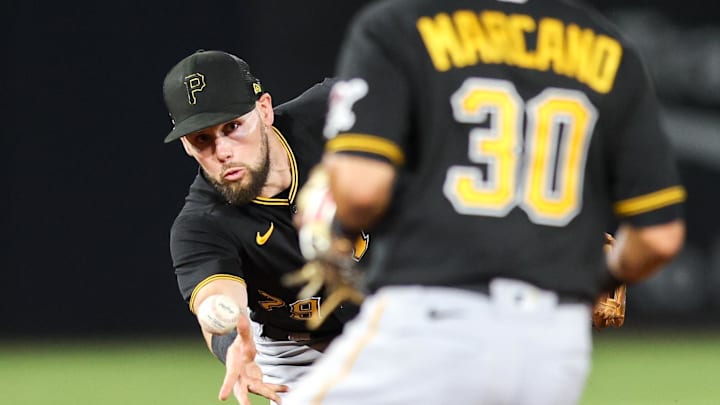There are three guarantees in life: death, taxes, and baseball fans overreacting about spring training results. If the Pittsburgh Pirates have taught anyone anything, it's that worrying over the pre-season is a waste of time.
The Pittsburgh Pirates are off to a rough start in spring training.
Entering play on March 8th, they're 3-6-2 with a run differential of -15. If you're on any social media, I'm sure you've already seen people ready to jump ship after a poor start. It's the way of baseball fans to panic after a poor spring. But if any previous Springs have told us anything, it's that one: Spring Training means very little, and two: spring training is not a preview for the season to come.
Over the past decade, the Pirates' three worst spring training seasons were 2016 (.276 winning percentage), 2018 (.367 winning percentage), and 2013 (.419 winning percentage). In all three seasons, the Pirates won at least 78 games. The Pirates went to the playoffs in one of those seasons, and the team went .500 or better in two of the three seasons.
On the other side of the coin, the Pirates' best three spring training seasons include 2017 (.613 W%), 2014 (.600 W%), and 2015 (.536 W%). Now sure, the Pirates did fantastic in 2014 and 2015, but one of their best spring training performances in recent history comes in a year where they finished the regular season below .500.
Over the last three full seasons (2018, 2021, 2022), the Pittsburgh Pirates have a regular season record of just 192-294, a winning percentage of just .395. But if spring training is indeed a preview of what's to come (like some people believe it to be), then the Pirates are severely underperforming. The Pirates have a spring training winning percentage of .493, which outpaces the Los Angeles Dodger spring training winning percentage of .478.
That was the Pirates' last three losing seasons (excluding counting 2020). So how have the Pirates done when they are good? The team's last three winning seasons are 2014, 2015, and 2018. Between those three spring training seasons, the Pirates have an almost identical winning percentage of just .494.
For those worried about individual players, let's take a look back at some spring training performances from the past. Jose Osuna is the poster boy for why spring training results do not matter. He's probably one of the best pre-season hitters of all-time.
In 2017, Osuna batted .407/.492/.759 with five home runs. The next pre-season, Osuna follows that up with a .327/.370/.673 line and five more home runs. Career wise, he has a .957 OPS and 11 home runs in 214 spring training plate appearances. But his major league performance those two seasons? A .231/.262/.417 triple-slash, only 10 home runs in over 330 plate appearances, and a wRC+ of just 76.
Kevin Newman was another spring training warrior, having an OPS of 1.429 in 2021, and then finished out the regular season with the lowest qualified OPS in baseball by 40 points. In spring 2016, Mike Morse outproduced both Andrew McCutchen and Starling Marte. Jung Ho Kang won the third base job in 2019 after hitting seven home runs in Spring of 2019.
Okay, so those were examples of bad players performing well in spring. But there are many other examples of good players performing poorly. A.J. Burnett consistently did terribly in spring, owning a 5.30 ERA throughout his pre-season career and a 5.86 ERA when he was a Pirate. Bryan Reynolds went 1-21 in his first spring with the Pittsburgh Pirates back in 2018. McCutchen had just a .793 OPS in spring before he started his MVP campaign. Tony Watson allowed seven earned runs in just 4.2 innings in 2013, then went on to start a three-season streak of an ERA below 2.50. In 2019, Josh Bell had a .563 OPS in spring, then went on to have what is still the best year of his career.
Baseball Reference's Spring Training leaderboard statistics include a statistic that measure the level of competition each player has faced. 10 is MLB-level, 8 is Triple-A, 7 is Double-A, and 4-5 is Low-A. Of the 75 pitchers who have thrown five or more innings, only five have faced anything better than Triple-A level, mostly falling into Quad-A level. Only 19 of the 298 batters with 15+ plate appearances have faced Quad-A level pitchers. No player has consistently faced MLB-caliber competition yet.
If I had a quarter every time I saw someone overreact to spring training, I could retire right now at 22 years old. It shouldn't have to be said that spring training means nothing, but some people take these performances to heart.
Players are still shaking off the winter rust. Others are working on their mechanics, trying out a new pitch, or changing something with their swing. The rest are facing pitchers who will likely get sent to Double or Single-A at the end of the preseason. Chances are, we have yet to watch a player give the level of effort you'd expect in a regular season game.
That doesn't mean they're not trying, but they're still getting warmed up and likely aren't at 100% yet. Let's also not forget we are looking at microscopic sample sizes. Starters don't start more than five games, and batters don't even get 100 plate appearances. If you're worried about results, then stop watching Spring Training because you'll be disappointed nine times out of ten, regardless of the team you root for. Winning is not the goal of spring training; it's about preperation and experimenting. On top of that, if Spring Training truly was a preview of the season ahead, then they should have out-performed the Dodgers in 2019, 2021, and 2022, Osuna should have been the next Barry Bonds, the Pirates were World Series favorites going into the 2017 regular season, and Burnett should have been DFA'd before the 2015 season got underway.
